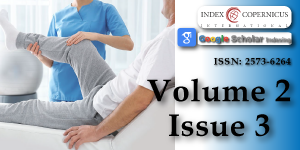Influence of an integrated rehabilitative treatment on the modification of body representation in patients affected by Unilateral Spatial Neglect
Main Article Content
Abstract
Background: In line with the so-called “embodiment concept”, human bodily experience is characterized by the immediate feeling that our body is localized in a certain position in space and that the self is localized within these body limits.
Aim: To verify in a cohort of patients affected by unilateral spatial neglect (NSU) secondary to cerebrovascular damage the possible correlation between a comprehensive neuromotor/neuropsychological rehabilitative treatment and the modification of body representation.
Setting: A rehabilitation institute for the treatment of neurological gait disorders and neuropsychological failures.
Methods: 12 patients (7 males, 5 females; mean age 60 ± 2yy) affected by NSU secondary to cerebral stroke and recovered in the Neurological Rehabilitation Section of the Clinical Institute Città di Brescia were recruited for the aim of this study. In accordance with our inclusion criteria we recruited 4 patients affected by ischemic stroke and 8 patients affected by haemorragic stroke; 9 patients of our study group arrived from a coma state period. Recruited patients underwent at time T0 (hospitalization day) to a functional impairment evaluation (Motricity Index = MI; Trunk Control Test = TCT; Functional Ambulation Category = FAC) and to a neuropsychological evaluation (Behavioural Inattention Test = BIT; Representional drawing; Personal Neglect evaluation scale); each evaluation was repeated in the same way at time T1 (intertime between 2 and 4 months after hospitalization) and time T2 (inter time between 5 and 6 months after hospitalization). At time T0 each patient began an individualized integrated (motor and neuropsychological) rehabilitative treatment course.
Results: In all patients recruited a statistical significant modification was observed for the MI LL left, the TCT and the FAC; no significant statistical modification was observed for the MI UL left, the MI UL and the MI LL right. The t-test showed a significant statistical modification of the personal neglect evaluation scale while no significant statistical modification was defined for the spontaneous human figure drawing test proceeding from time T0 to time T1. The spontaneous drawing of the human figure showed an individual different trend and modification in all patients recruited. A correlation analysis was made comparing the mean value of all motor scales (G1) with the mean value of all neuropsychological scales (G2) and no statistical significant correlation was observed between G1 (T0) and G1 (T1), G1 (T0) and G2 (T0), G1 (T0) and G2 (T1), G2 (T0) and G1 (T1), G2 (T0) and G2 (T1), G1 (T1) and G2 (T1). A second correlation analysis was made comparing all single motor scales with the neuropsychological scales, for the group made by 12 patients and the group made by 5 patients. For the group made by 12 patients, we observed the subsequently significant correlations: MI UL left (T0) correlates with MI LL left (T0); MI LL left (T0) correlates with MI LL left (T1); MI UL left (T1) correlates with MI LL left (T1); MI LL left (T1) correlates with FAC (T1); TCT (T1) correlates with FAC (T1). For the group made by 5 patients, we observed the subsequently significant correlation: TCT (T2) correlates with FAC (T2). In the group made by 12 patients, the mean amelioration of the time related normalized (T0-T1) motor scales is equal to 49% while to 63% was observed for the neuropsychological scales. The mean amelioration of the neuropsychological scale proceeding from time T0 to T1 is equal to 26% with an increase equal to 57% proceeding from time T1 to T2. The neurocognitive amelioration can be observed especially between the 5th and 6th month from the ischemic cerebral damage with a mean increase from 26% to 57%.
Conclusions: It would certainly make sense to treat patients with NSU from the neuropsychological point of view in the long term and from the neuro-motor point of view in the first 3-4 months after stroke; in all this, we cannot exclude that an improvement of the visuo-spatial exploration, emphasized by the neuropsychological treatment, can positively influence also patient’s motor outcome.
Article Details
Copyright (c) 2018 Falso M, et al.

This work is licensed under a Creative Commons Attribution 4.0 International License.
Gallagher S, Brosted S. Experimenting with phenomenology. Consciousness and Cognition. 2005; 15: 119-134. Ref.: https://goo.gl/UgwHJc
De Vignemont F. Body schema and body image – pros and cons. Neuropsychologia. 2010; 48: 669-680. Ref.: https://goo.gl/UigtsX
Coslett HB. Evidence for disturbance of the body schema in neglect. Brain Cogn. 1998; 37: 527-544. Ref.: https://goo.gl/4FuVDz
Kammers MPM, Van der Ham IJM, Dijkerman HC. Dissociating body representations in healthy individuals: differential effects of a kinaesthetic illusion on perception and action. Neuropsychologia. 2006; 44: 2430-2436. Ref.: https://goo.gl/r4wP5s
Moro V, Urgesi C, Pernigo S, Lanteri P, Pazzaglia M, et al. The neural basis of body form and body action agnosia. Neuron. 2008; 60: 235-246. Ref.: https://goo.gl/2Gd3vL
Jackson SR, Buxbaum LJ, Coslett HB. Cognitive neuroscience of bodily representations: psychological processes and neural mechanisms. Cogn Neurosci. 2011; 2: 135-137. Ref.: https://goo.gl/1Fq9b4
Zoccolotti P, Antonucci G, Judica A. Psychometric characteristics of two semi-structured scales for the functional evaluation of hemi-inattention in extrapersonal and personal space. Neuropsychological Rehabilitation. 1992; 2: 179-191. Ref.: https://goo.gl/mComgC
Wilson B, Cockburn J, Halligan P. Development of behavioural test of visuospatial neglect. Arch Phys Med Rehabil. 1987; 6: 98-102. Ref.: https://goo.gl/PRrDjH
Pizzamiglio L, Cappa S, Vallar G, Zoccolotti P, Bottini G, et al. Visual neglect for far and extra-personal space in humans. Cortex. 1989; 25: 471-477. Ref.: https://goo.gl/gmo24o
Berti A, Làdavas E, Della Corte M. Anosognosia for hemiplegia, neglect dyslexia and drawing neglect: clinical findings and theoretical considerations. J Int Neuropsychol Soc. 1996; 2: 426-440. Ref.: https://goo.gl/Gc4eky
Morasso P, Casadio M, Mohan V, Rea F, Zenzeri J. Revisiting the body-schema concept in the context of whole body postural focal dynamics. Front Hum Neurosci. 2015; 17: 9-83. Ref.: https://goo.gl/pKMD66
Kerkhoff G, Schenk T. Rehabilitation of neglect: an update. Neuropsychologia. 2012; 50: 1072-1079. Ref.: https://goo.gl/NwkthN

